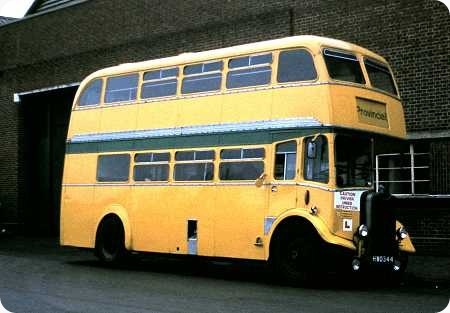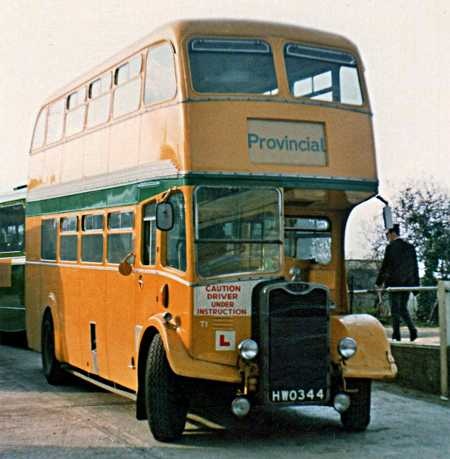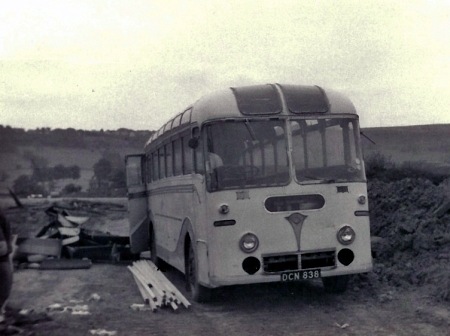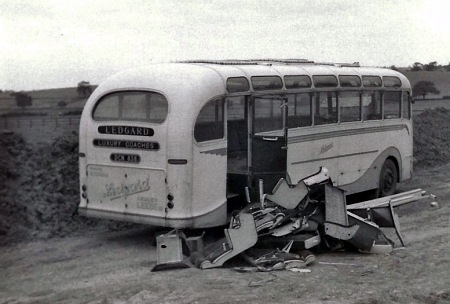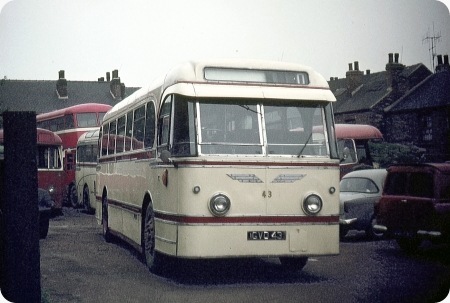
Copyright Ian Wild
T D Alexander (Greyhound) Sheffield and Arbroath
1952
Guy Arab UF
Alexander C41C
This coach was one of a batch of ten new to Central SMT in this case as their fleet number K43. Bob Alexander liked rugged reliability and from my conversations with the fitter at Greyhound, this vehicle fitted the bill being quoted as the most reliable vehicle in the fleet! It must have been a long drive between Sheffield and Arbroath in those mainly pre-motorway days. The coach is seen on 25 May 1968 amongst the typical junk in the depot yard at Surbiton Street in Sheffield. How I wish I had recorded (and kept) details of the wondrous collection of rolling stock to be seen there.
Photograph and Copy contributed by Ian Wild
29/06/12 – 11:27
Picking up a thread that has come and gone along the way. Alexander used to build a lot of vehicles either for, or to the designs of, other builders – particularly Leyland and Weymann. They had a coach which, fitted on the Royal Tiger, had a "a lot of" Leyland in it. Looking at this vehicle, it seems to have "a lot of" Weymann Fanfare in it – except that it pre-dates the Fanfare by some four years!
David Oldfield
30/06/12 – 05:31
Was Central SMT much of a coach operator? I’ve never tended to think of them as such. I believe these vehicles had bus type folding doors on the centre entrance. One of them found it’s way to Green Bus of Rugeley, Staffs and couldn’t have been any use at all for one man operation, the seating looks quite deep and comfortable though. Being a UF rather than an LUF, I imagine it would have been quite solid and rugged!
Chris Barker
30/06/12 – 05:32
Isn’t this the same body that "had a lot of" Leyland in it? It’s known as the Coronation style.
Peter Williamson
30/06/12 – 10:13
That’s what I thought Peter, but the "Fanfare" characteristics had only just dawned on me. Because I’m not over familiar with the Coronation, I couldn’t remember whether it had the Dutch lantern type windscreen of the Leyland coach.
David Oldfield
30/06/12 – 10:14
Like many of its underfloor contemporaries, it was over-engineered for British use, with a weight approaching, if not exceeding, at times, that of a double-decker, hence the lightweight LUF later. I think that all manufacturers subsequently produced lightweight versions, apart from Daimler. BMMO were definitely the front-runners in this sphere after the war.
Chris Hebbron
30/06/12 – 17:50
I think this view //www.flickr.com/ gives a more Leyland-like impression, but it is the same body.
I was a big fan of the Fanfare, and coincidentally my favourites of all were Northern General’s on Guy Arab LUF chassis.
Peter Williamson
30/06/12 – 17:51
Central SMT always had a few coaches, but mostly operated bus services in the Clyde Valley and along the north bank of the Clyde west of Glasgow.
They were the main profit making branch of the Scottish Bus Group in the post-war period and subsidised most of the other branches. They left coach operating to Alexander Bluebird, Western SMT and Eastern Scottish.
Jim Hepburn
01/07/12 – 08:23
Yes, Peter, add Fanfares to my list of favourites. I didn’t have much to do with the many Reliances but knew the Sheffield JOC Leopards very well.
David Oldfield
01/07/12 – 08:24
Central S.M.T. also had a fleet of "bald headed" Y type Albion Vikings which were quickly sold on to Highland. The Vikings were then replaced by Bedfords.
Oh to go back to Surbiton Street and see the Beverley Bar Guys and Leyland PD1’s. Also a fleet of ex Gateshead and District PD2’s. Even earlier they had a number of Bristol L types and possible older JO’s
Later they bought deckers from Aberdeen Corporation, Regent III’s and Regent V’s.
Stephen Bloomfield
01/07/12 – 08:25
As Chris says, most of the major manufacturers over engineered their early underfloor-engined models and had to introduce lighter models two or three years later – in some cases overreacting and going too far the other way. However, it seems to me that good old Bristol/ECW seemed to get it right from the start with their LS (Light Saloon). Just as with the BMMO’s, both manufacturers built what the operator wanted because the manufacturer and operator were closely related, and there was much more feedback flowing between them.
John Stringer
02/07/12 – 07:21
Like several of the other small fleets, Greyhound seems to have had a mixed fleet. It’s great for the observers, but I can imagine what it must have been like for the engineering stores people. It’s hardly surprising that so many fleets are standardised so heavily.
There’s comment above about the Leyland and Weymann similarities. I must say it looks rather more Weymann Fanfare than Leyland to me.
Pete Davies
02/07/12 – 18:00
I’m sure (or am I ?) that this particular coach GVD 43 used to operate on a works contract in and out of Halifax sometime during the mid to late 1960’s, but painted in a black and cream livery. Did it ever belong to Pemberton’s of Upton ? They did a works service to the Meredith & Drew biscuit factory from its home territory, later taken over (on a larger scale) by Halifax J.O.C.
John Stringer
03/07/12 – 07:19
Green Bus of Rugeley (Staffs) had identical machines GVD 41 and 44. I was lucky enough to ride on GVD 41 on their stage service from Stafford to Uttoxeter on one occasion, so yes they were used on bus work. The view from the front seat made a pleasant change, and the vehicle was an interesting contrast to the North Western Leopard/Alexander Y type which had taken me from Manchester LMS to Stafford!
Neville Mercer
03/07/12 – 07:22
So, were Pemberton’s the firm alluded to in Geoffrey Hilditch’s "biography" as having supplied a coach with " . . .a broken accelerator spring. A piece of string was secured to the pedal, and the free end given to the young lady sitting right behind the driver who was asked to provide the necessary tension . . ."? – which led, amongst other issues, to the contract being re-allocated to Calderdale JOC. I must admit that, given postings in another thread,and the timings, whether "GH’s" comments might have been aimed at Hebble – but seemingly not.
Philip Rushworth
04/07/12 – 05:38
Talking about Pembertons of Upton reminds me that when I drove for Stanley Gath at Dewsbury every year a large private hire job was for Thornhill Working Mens Club. This involved nearly all the fleet plus several other coaches hired in. On one occasion the destination was the inevitable Blackpool and one of the coaches was an elderly Bedford of Pembertons and as we loaded up at the club each coach took on pop and crisps for the children. When the driver of the Pemberton coach opened up his boot lid this fell off. Stanley himself was supervising loadings and he sent the driver and the coach back to his garage muttering that he would not use them again.
Philip Carlton
27/12/14 – 05:20
My dad went to Sheffield in late 1947 to re-letter Greyhound buses before they could be nationalised – he had a painters/sign writing business in Monifieth near Dundee, would anyone know the story behind this?
Jim Clark
06/01/15 – 17:30
Answer for Jim Clarke. I am the daughter of Geoff Alexander, his father was Thomas Daly Alexander the owner of Greyhound Coaches of Sheffield and Arbroath…I asked mum but she doesn’t know anything about that time as it was before she was married. But she remembers a house in Broughty Ferry that Thomas had and behind it they did sign writing, was that your dad?
Geoffs Daughter
22/02/15 – 07:38
Re Greyhound I distinctly remember it was winter 1947 he went to Sheffield as my mum was worried due to the bad winter of 47 – it was something to do with the nationalisation of coach services and to keep new coaches out of the hands of the government – I recall a holiday when we went all round England in the mid 50’s when we went down Snake Pass as Dad said this was the road he went to Sheffield in the snow of ’47 – my Grandad was also a signwriter and he probably stayed back in Monifieth to carry out more work to coaches there. This may be a mystery that will never be solved.
Jim Clark
 Vehicle reminder shot for this posting
Vehicle reminder shot for this posting
08/06/19 – 07:55
Tom Alexander was Walter Alexander’s other Son. He worked for the Company pre-war and was Depot Engineer at Dundee during the war. He was against nationalisation so left Alexanders and set up as Greyhound in Sheffield. The type of business he set up there was not involved in the Nationalisation of Bus Companies.
Allan T Condie
